MOTOCROSS ACTION’S 2009 450 SHOOTOUT: ALL THE FACTS WITHOUT THE WHITEWASH! EVERYTHING YOU NEED TO KNOW
Historically, choosing shootout winners is easy for the MXA wrecking crew. We race the bikes every weekend for six months, switch back and forth (sometimes between motos), try every possible gearing and suspension combination, and then, by universal acclaim, anoint the bike that was the standout performer. It’s easy!
Never has it been so hard as in 2009.
When asked to pick the 450cc four-stroke of the year, most MXA test riders just stared back with a blank look of confusion on their faces. Should they pick the one with the most horsepower? KTM. What about the one that handled the best? Suzuki. Wouldn’t the fuel-injected bike with the best powerband be the winner? Kawasaki. Doesn’t innovation count for anything? Honda. Shouldn’t the best suspension be the deciding factor? Yamaha.
When push came to shove and the MXA test riders were forced to pick the best 450cc four-stroke on the showroom floor today, they all asked, “Can I pick the 2008 Honda CRF450?” The answer was no.
To find out which one we picked, start reading here and, whatever you do, don’t jump to the end (or you will miss the whole story).
WHO MADE THE MOST CHANGES IN 2009?
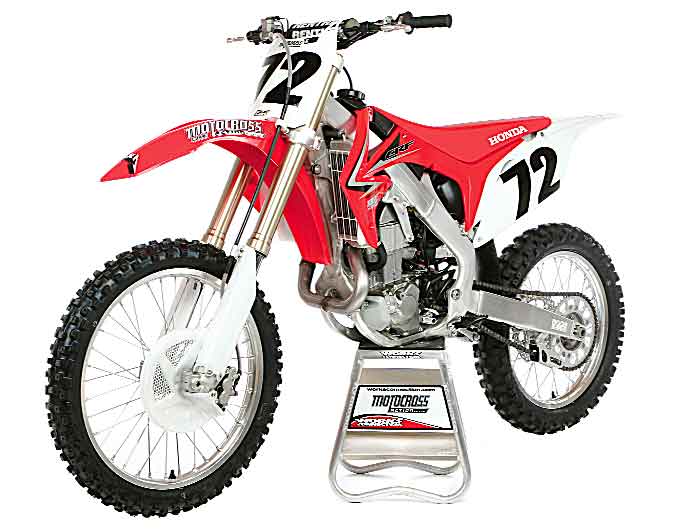
(1) Honda. You have to give Honda credit. They swung for the fences with the 2009 CRF450. It has a totally new frame, Kayaba suspension, fuel injection, redesigned plastic, radically different geometry, pulled-back triple clamps, and a brand-new engine. It is so revised that only the hubs, handlebars and brakes are holdovers from 2008.
(2) Kawasaki. When it comes to making changes for 2009, Kawasaki gave nothing up to Honda. Kawasaki changed the frame, fuel injection, plastic, triple clamps and geometry. Although they didn’t build a totally new engine, they came pretty close. Honda and Kawasaki bet the farm on totally new bikes for 2009.
(3) Yamaha. Unlike the KX450F and CRF450, Yamaha took a much more studied approach to the 2009 YZ450F. They skipped fuel injection in favor of the reliable Keihin FCR carb, and instead of redesigning the complete frame, they concentrated on shaving weight off of the swingarm, rear hub and shock linkage. The key word when talking about the 2009 Yamaha YZ450F is “unsprung.” Yamaha knocked 1.3 pounds of unsprung weight off the rear of the YZ450F. That is a smart weight savings.
(4) KTM. The Austrians used 2009 to refine the 2008 KTM 450SXF package. By focusing on a wide range of small details, KTM made some significant improvements to the overall bike. Stiffer springs (front and rear) and a lighter valve train bring the 450SXF up in its stroke and give it better throttle response.
(5) Suzuki. If you were expecting a totally new 2009 Suzuki RM-Z450, you must be disappointed when the tooth fairy only leaves a quarter under your pillow. This bike was all-new last year (and, for practical reasons, never really saw the light of day). Suzuki invested heavily in the short-circuited 2008 model?and 2009 is a chance for it to make it to the marketplace in large numbers. How can you tell a 2009 from a 2008? The yellow front number plate.
WHO HAS THE BEST ALL-AROUND POWERBAND?

(1) KTM. Never has a powerband had such an easy time winning the power crown. Not only did KTM build the most unique powerband on the track, but they benefitted from the miscues of Kawasaki, Honda, Suzuki and Yamaha. The KTM is a paradox. On the one hand, it is incredibly easy to ride. On the other hand, it is the most powerful 450 four-stroke made. How can it be both? The KTM builds power in a linear fashion. It starts out gentle and expands as it goes. By 7500 rpm, it is a horsepower better than the blue, green, red and yellow bikes. By the time the engine reaches peak horsepower, it is making close to 54 horsepower (no one else can break 53).
(2) Kawasaki. For a fuel-injected bike, the KX450F is as good as they get. As a rule of thumb, most fuel-injected 450s have terrific low end, impressive mid and then either a very flat top end or no top end. Kawasaki broke the mold. It is a match for its EFI brethren (RM-Z450 and CRF450) to 7500 rpm, and then, as they start gasping for breath, the KX450F rolls on over the top (with a healthy three-horsepower advantage over the other EFI bikes at 8500). Although it can’t touch the KTM after 7000 rpm, no other bike can touch the KX450F either.
(3) Honda. If you laid the CRF450, KX450F and RM-Z450 dyno charts over each other from off idle all the way to 7000 rpm, you would be hard pressed to tell them apart. They all offer tremendous low end power, amazing throttle response, and a solid advantage over a carburated bike up to seven grand. After that, the picture isn’t all that good for the CRF450. It continues to make power until 8200 rpm?then it goes flat. The CRF450 powerband hangs at around 50 horsepower from 8200 rpm all the way to 11,000 rpm.
(4) Suzuki. The RM-Z450 powerband is classic EFI. Strong on the bottom, powerful from low-to-mid and then flat after 8000 rpm. Unfortunately for the RM-Z450, it doesn’t stay flat for very long. At 10,200 it hits a wall and signs off. It doesn’t trail off. It just slams off. There is no over-rev on the RM-Z450.
(5) Yamaha. The Yamaha is slow. Not just slow compared to the CRF, KX-F, SXF and RM-Z, but slow compared to the 2007 YZ450F. It never makes more horsepower at any part of the curve than its competitors. It does beat the RM-Z450 after 10,000 rpm, but only because the Suzuki signs off. Yamaha’s decision to spec its power-robbing “ice cream cone” muffler has to be the biggest miscalculation in modern motocross. You can race the YZ450F by holding it on longer, but you will lose if the other guy holds his six-horsepower-more-powerful bike on just as long.
HOW DO THEY RUN ON THE DYNO?
(1) KTM. At 5000 rpm the KTM 450SXF ranks fourth in dyno roulette. At 6999 rpm it has moved into third. By 7001 rpm (just two rpm later), it is number one with a bullet. From that point on, the linear KTM power output just keeps on climbing?-and it doesn’t sign-off until 11,300 rpm. This bike is the king of the dyno.
(2) Kawasaki. Kawasaki is the second most powerful bike on the dyno. It is super strong and torquey at low rpm and shows no signs of flattening as the rpm climbs. Unlike the other fuel-injected bikes, which seem to stumble around 8000 rpm, the KX450F keeps right on pulling to 9400 rpm. It has the best powerband of any EFI bike.
(3) Honda. On the track, the initial jolt of the CRF450 is enough to blow you off of the back of the bike, and on the dyno you can feel the power at the crack of the throttle also. The CRF450 is very good from idle to 7300 rpm, then the CRF begins to taper off. By the time it peaks out (at a rather pedestrian 50.25 horsepower), the rev meter has only climbed a little above 8000 rpm. From there on the Honda engine just surges into a head wind. It revs a long way, but doesn’t make any additional power after 8200 rpm.
(4) Suzuki. It was the first fuel-injected bike sold and set the pattern for how virtually every EFI bike runs. It is responsive down low and very good from idle to 8000 rpm. Then it hangs until 10,000 rpm and dies a hard, fast and loud death. In the process, the Suzuki manages to just crack 50 horsepower at peak?50.8, to be exact.
(5) Yamaha. Shove a rag in the air box of the red, green, yellow and orange bikes and they will run just like the 2009 Yamaha YZ450F. It is a grim picture. Need proof? At 6000 rpm, the YZ450F gives up seven horsepower to the KX450F. At 7000 rpm, it is still working with a three-horsepower deficit to the KX450F. By 8000 rpm, it has handed the KTM 450SXF a five-horsepower boost. At 9000 rpm, the KTM is nine horsepower stronger. At 10,000 rpm, the YZ450F is three horsepower down on the KTM. And, at 11,000 rpm, the gap is back to eight horsepower between the class-winning KTM and the class-losing YZ450F.
WHICH ONE HANDLES THE BEST?

(1) Suzuki. When you develop a machine that focuses the majority of its attention on cornering prowess, you must dance a fine line. The RM-Z450 is just such a machine. With its super-steep head angle, the Suzuki can dive to the inside in any turn, carve with precision through the most daunting of ruts and track like an arrow on flat terrain. Of course, to get you have to give, and the RM-Z450 requires careful setup of the race sag and fork height to get the most out of the chassis. If you miss the setup by a millimeter, the RM-Z can become a handful. That is the dance, and when you do it right, it is a thing of beauty.
(2) KTM. There was a time (called the ’70s, ’80s and ’90s) when the idea of a good handling KTM was anathema. Surprise! KTM has designed a chassis that doesn’t have the old hinged feeling of the past. The front end tracks true, and the previous understeer is gone. To get the most out of the KTM you need to work with the suspension setup, but the chassis is capable of very good things.
(3) Yamaha. With the exception of the push in the center of the corners, the YZ450F is a stable, predictable and consistent handling bike. What makes the single flaw so egregious is that it has been the subject of both discussion and retrofit repairs for several years. It resists all efforts to iron it out. In truth, most MXA test riders can live with the quirky push (and even reduce it with creative setup) because in 90 percent of the corners, especially in loam, sand or ruts, the push is a non-issue.
(4) Kawasaki. The strange thing about the 2009 KX450F is that the Kawasaki engineers went all out to remedy the chassis’ tendency to stand up whenever the bike is leaned over on flat terrain. The swingarm pivot was raised, the offset changed from 24mm to 23m, the head angle steepened, weight reduced and aluminum tubing downsized. All of that work was for naught, because the 2009 chassis feels identical to the old chassis.
(5) Honda. The 2009 Honda CRF450 can turn really tight. So tight that it tends to oversteer. So tight that the front end has no bite on the entrance to corners (although it does bite when it tucks under). So tight that sometimes the only way to stop it from wandering is to throttle-steer it on exit. The overly soft front forks contribute to the CRF450’s unusual handling traits, but even with stiffer forks its handling is still very reminiscent of a 2002 Honda CRF450.
WHICH 2009 BIKE HAS THE BEST FORKS?
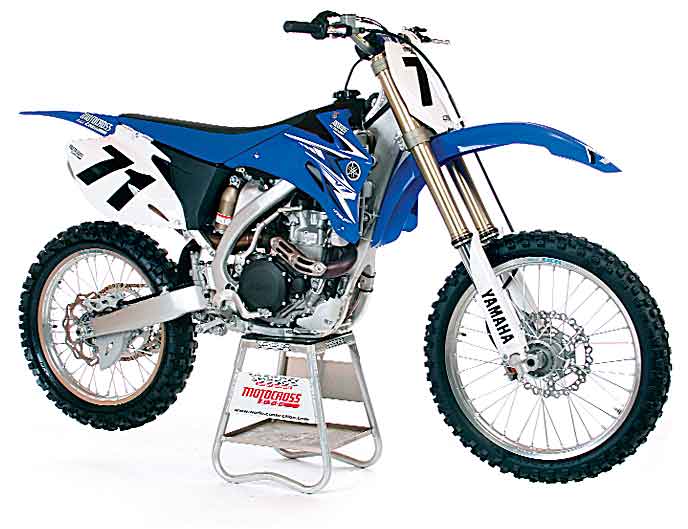
(1) Yamaha. Yamaha’s speed-sensitive damping system is light-years ahead of what the other manufacturers offer. When you add Kayaba’s class-leading damping system to a hardcore testing department that isn’t afraid to spec stiff spring rates, you get the best forks sold.
(2) KTM. Not bad. By that we mean not bad for something from the Dutch WP factory. For 2009, KTM stiffened up the 450SXF’s spring rate (from 0.48 kg/mm to 0.50), bought fork tubes and stanchions from the same Japanese supplier that their competition uses, and lowered the oil height enough to lessen midstroke harshness.
(3) Kawasaki. Most MXA test riders liked Kawasaki’s Kayaba AOSS forks (even though they were stiff by all-around standards). For most test riders, the spring rates were ballpark. And the plus of having the adjusters turned out was that we could turn them in as the forks wore in. Not great forks, but they look good in comparison to KTM, Honda and Suzuki because Kawasaki spec’ed decent spring rates and sufficient damping.
(4) Suzuki. There is someone at the Suzuki factory spec’ing spring rates that are impossibly soft for the job. The RM-Z450 forks are too soft for the age, weight and skill of a rider who buys a 450cc motocross bike. Stiffer fork springs are required to keep the front end up through hard braking and over mid-to-large scale bumps. We swapped the stock 0.47 kg/mm springs for 0.49s.
(5) Honda. When Honda’s engineers moved the front wheel 17mm closer to the crankshaft and the rear wheel 18mm farther away, they shifted a tremendous amount of energy to the Kayaba forks. Then, as if to compound the weight bias change, they spec’ed the 2009 CRF450 with very soft 0.46 kg/mm fork springs. We can understand their desire to avoid the midstroke harshness of last year, but they over-compensated.
WHICH 2009 BIKE HAS THE BEST SHOCK?
(1) Yamaha. When Yamaha announced that they were going to totally redesign the swingarm, linkage mounts and shock linkage on the 2009 YZ450F, every MXA test rider cringed at the thought. Why change what works? It turned out that Yamaha wasn’t messing with success. They moved all the mounting points, but kept the rising rate ratio exactly where it was. That is a good thing.
(2) Kawasaki. The KX450F is only four years old. When it was first introduced in 2006, the rear suspension was atrocious. It got a little better in 2007, a skosh better in 2008 and is improved again in 2009. The 2009 KX450F is very sensitive to balance between the front and rear. When you get the bike flatter, lower and dialed in, the rear suspension is decent (wallowy, but decent).
(3) Suzuki. Kawasaki and Suzuki are close to each other in the shock ratings. We were happy to discover that the RM-Z450’s rear shock spring wasn’t as soft as the front fork springs (but heavy riders should go up immediately). This is a decent shock that will come into its own once you stiffen up the front forks.
(4) Honda. Most of the troubles with the rear of the 2009 CRF450 are caused by the front end. Once you stiffen the front up enough to get 100mm of race sag, the rear shock begins to work. The 5.4 kg/mm spring rate is stiff enough for riders up to and over 200 pounds (smaller riders, 175 and under, will have to go softer).
(5) KTM. Unlike the rest of the world, the MXA test crew doesn’t blame KTM’s rear suspension woes on its no-link design. Linkage or no linkage, there is still a comparable rising rate. KTM may not have found the correct rate for their shock design, spring rates and valving, but the system isn’t to blame. Even though KTM upped the shock spring rate, we still complained about low-speed/high-load bottoming and a tendency to skip in off-throttle situations.

This chart is a combination of dyno and seat of the pants information. It is accurate, but not scientific.
WHICH BIKE HAS THE BEST STOCK JETTING?
(1) Yamaha. Isn’t it strange that the bike that delivered the best fuel flow, most on-demand power and spot-on jetting was one of only two bikes with a carburetor? In stock trim we had no jetting issues with the YZ450F Keihin. If you run an aftermarket exhaust pipe, you might need to swap the stock 160 mainjet for a 165 and raise the needle one clip position.
(2) Honda. There are three EFI bikes in the 450 class. All three of them have terrific throttle response from low-to-mid, super power off the bottom and are exceptionally crisp off idle. How can we choose which one is jetted the best when none of them have jets? The answer is that we graded them based on their ability to respond instantly, their tendency to pop in off-throttle situations and their willingness to stay centered after being modified. The Honda was scary crisp off the bottom, didn’t pop or bang when test riders breathed the throttle and accepted exhaust pipes without a whimper.
(3) Suzuki. In our opinion, the Suzuki is a little rich in stock trim, but this really helps when you begin to hop the engine up. Paradoxically, we always seemed to have a little trouble at the end of long motos with engine heat causing the RM-Z450 to go lean and start popping. Another nagging issue was the “hard” rev limiter, which cuts the ignition so quickly that the bike falls on its face. When the rev limiter kicks in, the RM-Z450 bangs, bucks and pops. And, when you back off and shift to the next gear, it pops a few more times for good measure. We’d like a “soft” rev limiter like every other 450.
(4) Kawasaki. It is important to note that the differences between the CRF450, RM-Z450 and KX450F are negligible. These bikes use the same basic throttle bodies, fuel pumps and sensors. The KX450F felt well fed, which played out as extra power under a load but did lead to the occasional pop on
deceleration.
(5) KTM. In the real world we would rate the KTM 450SXF jetting up with the Yamaha YZ450F, but our bike had some serious accelerator pump issues. We had to adjust the pump’s cam arm to keep the 450SXF from rasping at low rpm. We set the accelerator pump adjustment screw exactly one turn out from contact with the pump cam. That fixed it.
WHICH 2009 BIKE HAS THE BEST GEARING?
(1) Suzuki. Suzuki’s gearing is decent for the type of power the bike makes.
(2) Yamaha. Yamaha’s stock gearing would be really good if the Yamaha made more horsepower. With the stock exhaust system, we gear it down one tooth to help give the bike more oomph out of the corners. If you add an aftermarket pipe, the stock gearing is perfect.
(3) Honda. We never really found gear ratios that we liked with Honda’s relatively short power curve. Most test riders felt that the stock 13/48 gearing was too tall (aggravated by the gap between second and third). At 13/49 it was good for Novice and Intermediate riders, but pro-level riders complained that they wanted it to be lower than stock, but taller than the new gearing. For them we used a 14-tooth countershaft sprocket and a 52-tooth rear sprocket. This combo split the difference.
(4) KTM. The four-speed KTM 450SXF is geared too tall for the gaps between each gear. The quick fix for fast riders was to gear it down by one tooth to bring second gear closer to third (remember that KTM’s first gear is everybody else’s second gear). Paradoxically, slower riders geared it one tooth taller so that they could use first gear more often (on the theory that if KTM’s first is really second, there is no embarrassment in using first gear more).
(5) Kawasaki. This gearbox has been troublesome since 2006. First introduced in 2006 as a very gappy four-speed (that we geared down to use as a three-speed), Kawasaki made it a five-speed in 2007. But, the five-speed mod only consisted of tacking a fifth gear on top of the old four-speed tranny (although first gear was raised a little). As it sits in 2009, it is still the same old three-speed from 2006. We geared it down to make second gear come into play sooner.
WHICH 2009 BIKE HAS THE BEST BRAKES?
(1) KTM. No competition. KTM was so confident in the power of their front brake that they actually detuned them for 2009. It is still the best front brake. The rear brake takes a little getting used to, but it is yards better than it was a few years ago.
(2) Yamaha. The YZ450F has reliable and maintenance-free brakes, but they aren’t awesome, incredible or powerful. They stop the bike, but they don’t impress you in the process.
(3) Suzuki. Their front brake is solid and trouble-free. We have always had adjustment problems with the rear brake. If we set the pedal up with too little free play, the rear brake can overheat.
(4) Kawasaki. Maybe it is just us, but we always feel the need to bleed our KX450F brakes. They feel spongy when new and never really get a solid feel. For old-school riders who want to run the rear brake pedal low, we had to cut some threads off of the rear master cylinder’s threaded rod.
(5) Honda. The CRF450’s brakes were strong enough to live with, and they have really good adjustment capabilities on the rear pedal, but we noticed when we raced the bike back-to-back that the front brake got spongy and the rear brake squealed. Both of these problems are heat induced. Our solution? We removed the disc guards front and rear to get more air to the rotors.
WHICH 2009 BIKE HAS THE BEST STOCK TIRES?
(1) Suzuki. Suzuki’s Bridgestone M403/404 tire combo is a decent tire choice. Of all the Bridgestone tire combinations, this is a good set of sneakers.
(2) Yamaha. We don’t like the Dunlop 742FA front tire, especially when combined with the ultra-wide 120/80-19 rear tire. Most MXA test riders prefer the 110/90-19 rear Dunlop 756 tire mixed with a Dunlop D756 or D745 front.
(3) Honda. We are always confused about why manufacturers spec questionable front tires. The CRF450 comes with a 742FA front tire, which is a renovated version of the much-despised D742F, but it’s still not a tire that will make the most out of the bike’s handling. The rear is a Dunlop 756. This is a tire we like.
(4) KTM. KTM specs their bikes with a very old-school Bridgestone M59/M70 tire combo. These are good sneakers, but not great ones. The M70 hasn’t been seen in a dealership in years.
(5) Kawasaki. Kawasaki must have gone to the vintage museum to spec the less-than-spectacular Dunlop D742F front tire. This isn’t even the newer D742FA, but the old, disgraced 742F. Why not just sell the bike without a front tire?
HOW WOULD THE MXA TEST CREW DESCRIBE EACH BIKE?
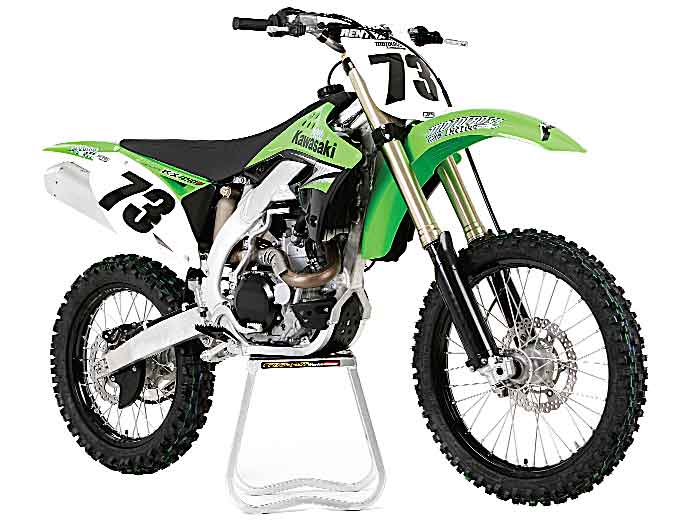
Kawasaki KX450F. In one sentence: A big runaway train of a bike with a stupendous powerband. We didn’t like the bulk of the KX450F, the gappy gear ratios, the poor shifting or the cranky handling, but we loved the powerband.
KTM 450SXF. In one sentence: With a powerband that never wants to quit, the KTM 450SXF makes the most horsepower, handles well and stops on a dime?-if only the rear shock worked all the time. The KTM shares some traits with the Kawasaki; both are big bikes with awesome powerbands and nagging flaws.
Yamaha YZ450F. In one sentence: If Yamaha had been smart enough to put a true-to-life exhaust system on the 2009 YZ450F, it would have won this shootout. Yamaha put themselves in a bind. We can’t pick a Bike of the Year that can’t get out of its own way?can we?
Honda CRF450. In one sentence: The 2009 Honda CRF450 is still a work in progress. To make it into a great motocross bike, the buyer has to furnish all the missing pieces of the puzzle. It reminds us of the original 2002 Honda CRF450…so close to perfection, yet so far.
Suzuki RM-Z450. In one sentence: The MXA wrecking crew doesn’t understand all the complexities of motorcycle manufacturing, but if Suzuki had reprogrammed the ignition for more over-rev and slipped in stiffer fork springs, the 2009 RM-Z450 could be on the top step.
450 SHOOTOUT WINNER…

(1) Kawasaki KX450F. No one will come out of the 2009 450cc four-stroke shootout without being bloodied. The Kawasaki KX450F gets a bloody nose for its gear ratios, shifting, size and push, but there are fixes for most of those wounds. On the plus side, the 2009 KX450F has the best fuel-injected powerband on the market, decent suspension and the second most horsepower.

(2) KTM 450SXF. When you make the most power and spread it across the widest imaginable range, you have the makings of a shootout winner. Add in sharp cornering and world-class brakes and you are onto something. Unfortunately, the blood-letting begins with the wide-ratio four-speed transmission and ends with the cranky rear shock.

(3) Yamaha YZ450F. The YZ450F has produced a solid package that is highlighted by the best showroom stock suspension, tremendous reliability, crisp jetting and decent ergos. Test riders only have two complaints: it doesn’t make competitive power, and it has a slight push in the center of the corners. Yes, we know that you could buy a pipe to regain some of the lost power, but then the already more potent bikes could buy pipes, and an arms race would ensue without any change in the bikes’ respective powerband ratings.
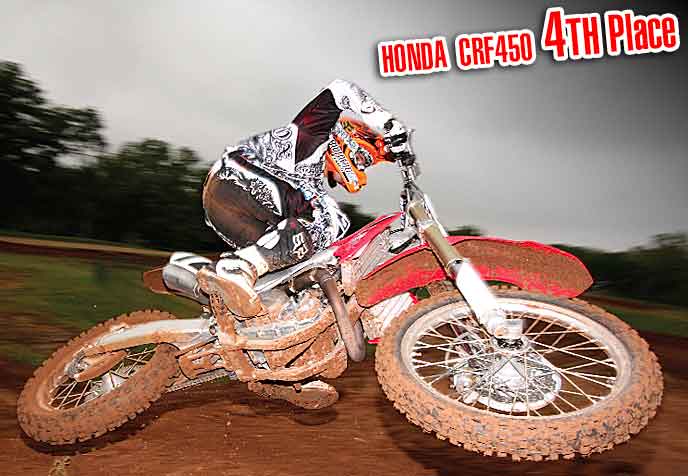
(4) Honda CRF450. For a first year bike, the CRF450 is snappy and over-responsive?and that describes both the power and the handling. To win this shootout the CRF450 would need more top-end power, stiffer forks springs, more damping in the forks, a flatter profile, stronger clutch and calmer steering response. As you would expect with a first-year bike, the CRF450 will get better.
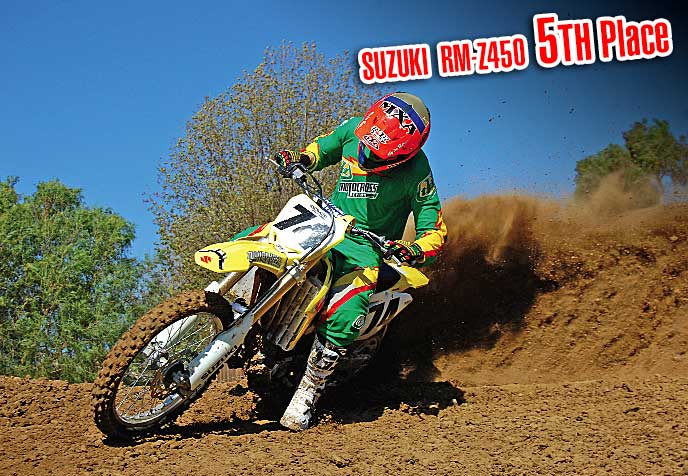
(5) Suzuki RM-Z450. In their second year of production, most new bikes get some of their flaws fixed. Not so with the RM-Z450. Suzuki was so focused on getting the bike into the showrooms and making sure that the right side cases didn’t crack that they didn’t make the two simple fixes that could have vaulted them upward (over-rev and fork springs).
MXA’S RECOMMENDED 2009 JETTING SETTINGS
YAMAHA YZ450F
Main: 160
Pilot: 45
Needle: NFLR
Clip position: Third from top
Fuel screw: 2-3/8 turns
Leak jet: 55
Notes: If you run an aftermarket exhaust pipe, swap the stock 160 mainjet for a 165 and raise the needle one clip position.
HONDA CRF450
Not applicable
KAWASAKI KX450F
Not applicable
SUZUKI RM-Z450
Not applicable
KTM 450SXF
Main: 182
Pilot: 40
Needle: OBDTP
Clip position: fourth from top
Fuel screw: 1-3/4 turns (1-1/2 turns stock)
Notes: We had a cough at low rpm that we couldn’t iron out with the fuel screw or needle. We set the accelerator pump adjustment screw exactly one turn out from contact with the pump cam. That fixed it.
MXA’S RECOMMENDED 2009 FORK SETTINGS
YAMAHA YZ450F
Spring rate: 0.47 kg/mm
Oil height: 350cc
Compression: 12 clicks out
Rebound: 12 clicks out
Fork leg height: 5mm up
HONDA CRF450
Spring rate: 0.48 kg/mm (0.46 stock)
Oil height: 350cc
Compression: Four clicks out (13 stock)
Rebound: Eight clicks out
Fork leg height: Flush
Notes: The 2009 CRF450 will work better with stiffer 0.48 fork springs, but the stock valving is inadequate (thus,we think that the forks need to be revalved). If you stick with the stock fork springs, slide the fork down into the clamps as far as reasonable to lessen the stinkbug stance and slow down the oversteer .
KAWASAKI KX450F
Spring rate: 0.47 kg/mm
Oil height: 340cc
Compression: 18 clicks out
Rebound: Ten clicks out
Fork leg height: 5mm up
SUZUKI RM-Z450
Spring rate: 0.49 kg/mm (0.47 stock)
Oil height: 370cc
Compression: 11 clicks out
Rebound: 11 clicks out
Fork leg height: 5mm up
KTM 450SXF
Spring rate: 0.50 kg/mm
Oil height: 390cc stock
Compression: 18 clicks out
Rebound: 21 clicks out
Fork leg height: 5mm up
MXA’S RECOMMENDED 2009 SHOCK SETTINGS
YAMAHA YZ450F
Spring rate: 5.5 kg/mm
Race sag: 100mm
High-compression: 1-1/2 turns out
Low-compression: 11 clicks out
Rebound: Ten clicks out (12 clicks stock)
HONDA CRF450
Spring rate: 5.4 kg/mm
Race sag: 115mm
High-compression: Two turns out (1-1/2 stock)
Low-compression: 11 clicks out
Rebound: 15 clicks out (14 stock)
Notes: The stock spring is good for rider 175 pounds and up, but lighter riders should go down one shock spring rate.
KAWASAKI KX450F
Spring rate: 5.5 kg/mm
Race sag: 100mm
High-compression: One turn out
Low-compression: Eight clicks out
Rebound: Eight clicks out
SUZUKI RM-Z450
Spring rate: 5.6 kg/mm
Race sag: 100mm
High-compression: Two turns out
Low-compression: Eight clicks out
Rebound: Eight clicks out
Notes: Faster riders might need a 5.8 spring.
KTM 450SXF
Spring rate: 7.2 kg/mm
Race sag: 110mm
High-compression: 1-1/4 turns out
Low-compression: 15 clicks out
Rebound: 24 clicks out
Notes: Fast or heavy rider should to a 7.6 spring.




Comments are closed.